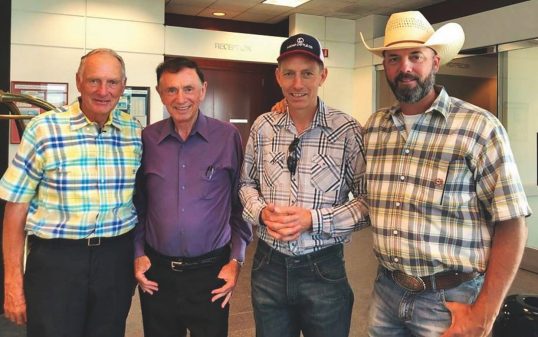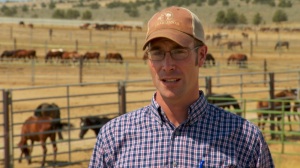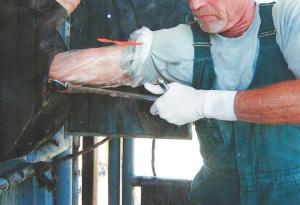Opinion by Bonnie Kohleriter
THE RENO NV SNAFFLE BIT FUTURITY
SEPTEMBER 8-15, 2019
It’s that time of year again when Rob Sharp, the Supervisor at the hidden BLM Burns Corral in Oregon, gets to sell those helpless two year old mustangs to Dave Duquette to be used in the Snaffle Bit Futurity in Reno, Nevada, September 8-15, 2019.
Dr. Thrill Seeker, Leon Pielstick, awaits eagerly for those helpless two year old mustangs, so that once again, he can stick his arm up their vaginas and rip out their ovaries with his ecraseur.
The Futurity bidders are in line to purchase one of those spayed two year old mustangs as they face the challenge to gentle them, saddle them, work them and of course, look forward to the $25,000 purse.
The mustangs will be asked, once again, to be ridden and to perform acts for which their non fused bones are not ready. But do these humans care about the abuse directed toward these innocent, helpless animals? After all, it’s all about “my self-indulgence, my pleasure, my entertainment.” Forget about what’s best for the horse.

Forrest Lucas (2nd from left) and Dave Duquette (on the right) of Protect the Harvest, with Dwight and Steven Hammond
And Forrest Lucas can continue to fuel his sadism toward these innocent animals, who he has never known. He uses them with his displaced emotions to strike back at the HSUS, who he sees as having done harm to him eons ago. Spaying these mustangs, working them in ways for which they are not to be used is, after all, Forrest’s way of preserving the ranching way of life that never really was. Yes, that would be the Forrest Lucas of Protect the Harvest who is financially supporting this Futurity and hopes to get rid of America’s wild horses by slaughtering or sterilizing them.
Forrest says in one mouth he wants to preserve the ranching way of life. The quarter horse Snaffle Bit Futurity Event using quarter horses has been the ranching way of life in Reno since the 1970s. Now Forrest wants to introduce spayed mustangs into what has not been the ranching way of life. Forrest appears to be a confused elderly person.
Please e-mail to the event expressing your thoughts toward the atrocity toward these young horses or write them: office@renosnafflebitfuturity.com or Reno Snaffle Bit Futurity, P.O. Box 70, Coarsegold, CA, 93614
Categories: Horse News











Are these Hammonds related to those connected with the Bundy takeover in the Malheur?
LikeLike
Yes. Forrest Lucas was the driving force behind their release from prison.
LikeLiked by 2 people
Wow. Quite a band of brigands then.
LikeLiked by 2 people
Protect the harvest? Let’s protect the horses from these people.
LikeLiked by 1 person
This whole thing is so barbaric! These are innocent horses too young to have to endure the racing scene especially after being tortured with that midevil surgery
They want to perform on these sweet fillies!
LikeLiked by 1 person
INTERIOR’S MUSICAL CHAIRS SPIN OUT OF CONTROL
Complaints Mount as Sagebrush Rebel Installed Over Wildlife and Parks
Posted on Jun 11, 2019
On May 23, 2019, Interior Secretary David Bernhardt quietly signed the 27th version of an order purporting to delegate duties of presidentially appointed positions to a series of acting officials. In this latest order, Bernhardt taps Karen Budd-Falen for the role of Assistant Secretary for Fish and Wildlife and Parks. Budd-Falen has spent her career challenging the legitimacy of federal wildlife protections in addition to fighting grazing regulations and other land use authority as part of the so-called Sagebrush Rebellion.
“Putting Karen Budd-Falen in this position is like putting Genghis Khan in charge of a day care center,” stated PEER Senior Counsel Peter Jenkins, pointing out that she was previously slotted into an Interior deputy solicitor job that required no Senate review. “Since David Bernhardt knows Budd-Falen is so right wing that she could never be confirmed for the job he just gave her, this maneuver only underlines the Administration’s continuing contempt for the Senate’s constitutional advice and consent prerogative.”
Today, PEER also filed a lawsuit against Secretary Bernhardt’s office for failure to respond to Freedom of Information Act requests seeking communications about his elaborate efforts to keep in place lower-level political appointees who violate requirements of the Federal Vacancies Reform Act to properly fill an “acting” designation.
“David Bernhardt is running Interior through a succession of shadow puppets,” added Jenkins. “Not only does the Senate lack an opportunity to question these people in open session but Interior is refusing to produce the paper trail explaining how and why these illicit acting officials got elevated.”
https://www.peer.org/news/press-releases/interior%E2%80%99s-musical-chairs-spin-out-of-control.html
REPORT
BERNHARDT’S BAD ACTORS or Interior’s Detour Around Senate Confirmation
Click to access 3_18_19_Bad_Actors_report.pdf
LikeLiked by 1 person
No Horse is Physically (Skeletally) Mature Before 5.5 to 6 Years Old
by Joe Camp
Below is the link to the best article I’ve ever read on this subject. It teaches that no horse, of any breed, in any country, at any time in history either now or in the past, has ever been physically (skeletally) mature before it is six years old (plus or minus a few months), including every healthy, domestically-raised male and most female horses on the planet. Gaited horses (Tennessee Walkers, American Saddlebreds, etc) can require up to 8 years to fully mature skeletally. Our Mouse (above) is a rescued Saddlebred.
This article is written by Dr. Deb Bennett Ph.D. Dr. Bennett is a 1984 graduate of the University of Kansas, and until 1992 was with the Smithsonian Institution. She is considered by many to be an authority on the classification, evolution, anatomy, and biomechanics of fossil and living horses.
Below are a few key quotes from the article (but I encourage you to take the time to read the entire paper).
The Link to the article:
Click to access ranger_piece_2008_pdf1.pdf
LikeLiked by 1 person
No Horse is Physically (Skeletally) Mature Before 5.5 to 6 Years Old
by Joe Camp
Below are a few key quotes from the article (but I encourage you to take the time to read the entire paper).
Click to access ranger_piece_2008_pdf1.pdf
“Believe it or not many vets are totally unaware, as many members of the general public are also unaware, that horses have more than one “growth plate”, that there are multiple ossification centers pertaining to every bone of the body outside of the skull, and that the schedule of growth-plate closure (which begins around the time of birth and extends until the sixth year, and is coordinated with the eruption schedule of the teeth) has been well known to veterinarians, paleontologists, zooarchaeologists, and mammalogists since the early 19th century.”
“There is no such thing [as a] slow-maturing breed. The Quarter Horse is not an ‘early maturing’ breed – and neither is the Arabian a ‘slow maturing’ breed. As far as their skeletons go, they are the same. This information comes, I know, as a shock to many people who think starting their colt or filly under saddle at age two is what they ought to be doing. “
It’s about more than just growth plates:
“While growth in cannon bone length stops with the fusion of both growth plates at around 1 ½ years of age, increase in cannon bone girth does not taper off until close to 5 years of age, and essentially the same can be said for the girth of any other limb element, with those bones located higher up in the body maturing later.”
It is the spine, not the limbs, that the horse primarily uses to govern overall coordination of the limbs
LikeLiked by 1 person
No Horse is Physically (Skeletally) Mature Before 5.5 to 6 Years Old (cont)
Click to access ranger_piece_2008_pdf1.pdf
“Most of the growth plates above the distal radius in a three year old horse are unfused, including, most importantly, those of the animal’s spine. It is the spine of the horse that governs the overall coordination of the limbs and the animal’s running “style”. It is the spine, not the limbs, that the animal primarily uses to compensate for potholes, slick spots, and other irregularities in the race track [or any track]. The higher the speed and the greater the physical effort, the more important it is that the animal have all of its joints mature and in good working order. While catastrophic failures are uncommon, more subtle distal limb disease and chronic pain and dysfunction in two and three year old racehorses are commonly diagnosed and are major causes for the “wastage” of young Thoroughbreds.”
“The demand for all-out speed from any animal that is not skeletally mature is a recipe for disaster.”
“What people often don’t realize is that there is a “growth plate” on either end of every bone behind the skull, and in the case of some bones (like the pelvis or vertebrae, which have many “corners”) there are multiple growth plates.”
“The lateness of vertebral “closure” is most significant for two reasons. One: in no limb are there 32 growth plates! Two: the growth plates in the limbs are (more or less) oriented perpendicular to the stress of the load passing through them, while those of the vertebral chain are oriented parallel to weight placed upon the horse’s back. Bottom line: you can sprain a horse’s back (i.e. displace the vertebral physes – see Figs. 5 and 8) a lot more easily than you can displace those located in the limbs.”
“So do you then have to wait [to start your horse] until all these growth plates convert to bone? No. But the longer you wait, the safer you’ll be. Owners and trainers need to realize there’s an easy-to-remember general schedule of fusion – and then make their decision as to when to ride the horse based on that rather than on the external appearance of the horse. For there are some breeds of horse – the Quarter Horse is the premier among these – which have been bred in such a manner as to look mature long before they actually are mature. This puts these horses in jeopardy from people who are either ignorant of the closure schedule, or more interested in their own schedule (for futurities or other competition) than they are in the welfare of the animal.”
“Bottom line: if you are one of those who equates “starting” with “riding”, then I guess you better not start your horse until he’s four. That would be the old, traditional, worldwide view: introduce the horse to equipment (all kinds of equipment and situations, with the handler on the ground) when he’s two, add crawling on and off of him at three, saddle him to begin riding him and teaching him to guide at four, start teaching him maneuvers or the basics of whatever job he’s going to do – cavalletti or stops or racing or something beyond trailing cattle – at five, and he’s on the payroll at six. The old Spanish way of bitting reflected this also, because the horse’s teeth aren’t mature (the tushes haven’t fully come in, nor all of the permanent cheek teeth either) until he’s six. This is what I’d do if it were my own horse.”
LikeLiked by 1 person
Dr. Bennett writes articles in Equus magazine which I used to subscribe to. The fact that breeders & trainers – not just of Thoroughbreds, but quarter horses, Apps, paints, Arabs – all breeds, dont use this information accounts for why current domestic horses are not bred, trained and cared for as they should be in order to raise strong, healthy foals. This tells it like it is. Sure does explain precisely WHY these poor, mis-used, & mis-treated babies live such short sad lives – just to increase someone’s pocketbook & of course, “entertain” the American public. Seems other countries have more interest in breeding horses that continue to – in thoroughbred’s case – race much longer and are in better shape.
When I was a kid, anything that had to do with horses really caught my eye. I know I’ve said this before, but every single equine discipline has a downside. And the animals are the ones who suffer for it. Frankly, the US animal welfare system sucks. From the treatment of our wild ones, Tennessee Walking Horses, Western disciplines, – all of them. Sorry to be so pessimistic, but anyone who cares about animals today, and I think there are more of us now, realizes there is so much to be done to make the system better.
LikeLiked by 1 person
Maggie, you are so right. The veterinary profession needs to also take a hard look at itself. Veterinarians must hold the standards to the highest level.
It should NOT be an exception when one of them speaks out and DOES tell it like it is.
LikeLiked by 1 person
Kind of like the veterinarians who have spoken out against the current BLM push to spay mares, right??
LikeLike
Interior Department border deployments are mired in secrecy
By Jessica Kutz on Jun 1, 2019
The program continues to grow, but oversight is lacking. On May 15, it was reported by The Hill that 47 Interior Department officers were currently assigned to the border
A separate FOIA request to the National Park Service shows that between May 2018, when the border surge program started, and mid-February of this year, the agency has had to spend more than $1.7 million on the deployments. This amount does not include money allocated to send officers from the BUREAU OF LAND MANAGEMENT or U.S. Fish and Wildlife Service to the Borderlands. While it might not seem like a significant amount compared to other federal expenses, it adds to the proposed 14 percent cut in funding to the Park Service outlined in the 2020 federal budget.
https://grist.org/article/interior-department-border-deployments-are-mired-in-secrecy/
LikeLiked by 1 person
Interior Department border deployments are mired in secrecy
By Jessica Kutz on Jun 1, 2019
See the documents HCN obtained for this story.
https://www.documentcloud.org/public/search/projectid:44248-DOI-Deployment
LikeLiked by 1 person